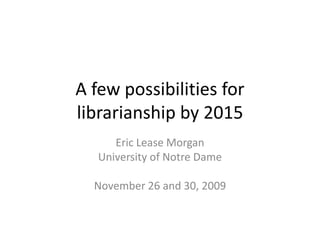A few possibilities for librarianship by 2015
- 1. A few possibilities for librarianship by 2015 Eric Lease Morgan University of Notre Dame November 26 and 30, 2009
- 2. Types of libraries There are many individual libraries, but there are only a few different types. No matter what type, they all share a number of core values, and the all support a set of similar services.
- 6. The whats of librarianship Libraries collect, preserve, organize, and disseminate data, information, and knowledge for the purposes of making the work of their respective communities easier. To one degree or another, just about everything us librarians do can be associated with one of these processes. These things are the whats of librarianship, and they change very slowly.
- 11. The hows of librarianship The hows of librarianship are the things of our everyday work, our day-to-day operations, the specific workflows within each of our libraries. The hows of librarianship change at a much faster pace, and these changes are usually driven by technology. And, librarians love lists
- 12. Catalogs are a good example
- 13. Journal indexes are another
- 14. Lists as indexes, not databases With the advent of freely available, industrial strength indexers ¨C not databases ¨C we have seen an evolutionary development in the creation of lists. This is the work of the ˇ°information retrievalˇ± community whose tools are mathematics, and the epitome of this community isˇ
- 16. ˇ°Smartˇ± computer indexes # calculate term frequency/inverse document frequency sub tfidf { my $n = shift; # number of times found in document my $t = shift; # total number of words in document my $d = shift; # total number of documents my $h = shift; # number of hits in the corpus my $tfidf = 0; if ( $d == $h ) { $tfidf = ( $n / $t ) } else { $tfidf = ( $n / $t ) * log( $d / $h ) } return $tfidf; }
- 17. ˇ°Next-generationˇ± catalogs One possible future for libraries lies in the re- creation of our venerable library catalogs, but I think this represents a limited visionˇ
- 19. Putting content into context Considering the current environment, a more promising future of libraries lies in making content more useful. Examples include: annotate, compare & contrast, create flip book, do concordance against, find opposite, find similar, highlight, incorporate into syllabus, plot on a map, print, rate, review, save, share, summarize, tag, trace citation, translate, etc.
- 20. Demonstrations (Psst, Eric, do a couple of demonstrations here!)
- 21. Customization/personalization Putting content into context is also a matter of understanding who your customers are, what they are trying to accomplish, and creating systems that seem to ˇ°knowˇ± these things.
- 25. Plan B - Archives A ˇ°Plan Bˇ± or another future of libraries lies in their ability to be more like archives. This work falls into two categories: 1) the work of ˇ°institutional repositoriesˇ±, and 2) the digitization of ˇ°special collectionsˇ±.
- 26. New ways to do old thing If this is the case, then you will need to use computer technology to: 1. Decide what content to include (collections) 2. Collect it (acquisitions) 3. Normalize it (cataloging) 4. Index it (systems) 5. Provide access to the index (public service)
- 31. Change happens s l o o w l y Books are not going anywhere. Journals are still the medium of formal scholarly communication. The licensing of content will continue. Because of these things, the work of librarianship as it stands today will change slowly over the next five years.
- 35. Evolution, not revolution Time and energy need to be spent now in order for change to become a reality, to discover new, additional, and supplemental roles for ourselves. The opportunities are only limited by our imagination and willingness to transform them into reality.




































